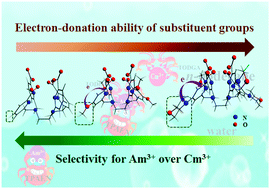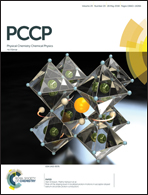Understanding Am3+/Cm3+ separation with H4TPAEN and its hydrophilic derivatives: a quantum chemical study†
Abstract
Am3+/Cm3+ separation is an extremely hard but important task in nuclear waste treatment. In this study, Am and Cm complexes formed with a back-extraction agent N,N,N′,N′-tetrakis[(6-carboxypyridin-2-yl)methyl]ethylene-diamine (H4TPAEN) and its two derivatives with hydrophilic substituents (methoxy and morpholine groups) were investigated using the density functional theory (DFT). The optimized geometrical structures indicated that the Am3+ cation matched better with the cavities of the three studied ligands than Cm3+, and the Am3+ cations were located deeper in the cavities of the ligands. The bond order and quantum theory of atoms in molecules (QTAIM) analyses suggested that ionic interactions dominated An–N and An–O (An = Cm and Am) bonds. However, weak and different extents of partial covalency could also be found in the Am–N and Cm–N bonds. The O donor atoms in the carboxylate groups preferably coordinated with Cm3+ rather than Am3+, whereas the N atoms preferred Am3+. Therefore, the Am3+/Cm3+ selectivity of H4TPAEN and its two hydrophilic derivatives may be ascribed to the competition between the An–N and An–O interactions and the few dissimilarities in their geometrical structures. Based on our calculations, the methoxy and morpholine groups in the two derivatives can serve as electron-donating groups and enhance the strength of the An–NPY bonds (NPY denotes the nitrogen atom of pyridine ring). When compared with the Am-complex, the Cm-complex exhibited significant strength effect, resulting in the relatively lower Am3+/Cm3+ separation ability of the H4TPAEN's hydrophilic derivatives.



 Please wait while we load your content...
Please wait while we load your content...